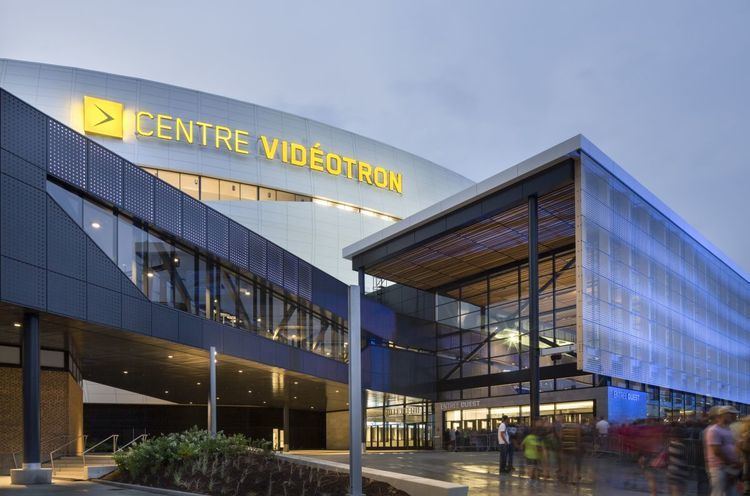Location Quebec City, Quebec Operator Quebecor Media | Owner Quebec City Phone +1 844-267-4472 | |
 | ||
Former names Quebec City Amphitheatre (planning stages and during construction) Capacity Ice hockey: 18,259
Concerts: 20,396 Field size 689,000 square feet (64,000 m) Address 250 Wilfrid-Hamel Blvd, Québec City, QC G1L 5A7, Canada Hours Open today · Open 24 hoursTuesdayOpen 24 hoursWednesdayOpen 24 hoursThursdayOpen 24 hoursFridayOpen 24 hoursSaturdayOpen 24 hoursSundayOpen 24 hoursMondayOpen 24 hours Similar Centre Bell, Colisée Pepsi, US Bank Arena, FirstOntario Centre, KeyBank Center Profiles | ||
The Videotron Centre (French: Centre Vidéotron) is an indoor arena in Quebec City, Quebec, Canada. The 18,259-seat arena replaced Colisée Pepsi as Quebec City's primary venue for indoor events. The new arena is primarily used for ice hockey, serving as the home area of the Quebec Remparts of the QMJHL and has been prospected as a venue for a new or re-located National Hockey League team in Quebec City, and as part of a Winter Olympic Games bid. The building opened on September 8, 2015. It is now the seventh-largest indoor arena in Canada.
Contents
Centre vid otron vues a riennes int rieures et ext rieures par drones
History
A groundbreaking ceremony for the new arena was held on September 3, 2012, attended by then-Quebecor Chairman Pierre Karl Péladeau, then-Premier of Quebec Jean Charest, and former Quebec Nordiques players Michel Goulet, Peter Stastny and Alain Côté. Arena construction began on September 10, 2012.
The arena was expected to cost $400 million, but cost $370 million instead; 50% of the cost will be covered by the city and province each. On March 1, 2011 Quebecor entered into an agreement to acquire management rights to the new arena, a deal expected to be between $33 million and $63 million up front, plus between $3.15 million and $5 million in annual rent. The value of the deal will increase if an NHL franchise moves into the arena; Quebecor has actively backed an expansion franchise for Quebec City. This arrangement was made without public tender, for which the provincial government provided legal immunity.
As part of the management contract, Quebecor also holds the arena's naming rights; on April 7, 2015, it was announced that the arena would carry the name of Quebecor-owned cable company Vidéotron, and be known as the Videotron Centre (Centre Vidéotron in French). The arena held its official opening on September 3, running public two-hour tours for the following three days. On September 12, Videotron Centre broke the Quebec Major Junior Hockey League attendance record by attracting 18,259 spectators to a match between the Quebec City Remparts and the Rimouski Oceanic. Metallica was the first musical attraction of the stadium, on September 16, two days after the band played the last concert held at Colisée Pepsi.
Design
The arena is comparable in size to the PPG Paints Arena, the home arena of the Pittsburgh Penguins, and occupies approximately 64,000 square metres of space, down from the originally proposed 70,000 square metres. The design is also similar to the Rogers Place, the home arena of the Edmonton Oilers. A television studio, valued at between C$30 million and C$40 million, is constructed within the arena.
In an interview for the American magazine Sports Illustrated, Populous architect and lead project designer Kurt Amundsen said that the arena was "absolutely a hockey-first design with the intention of them securing an NHL team in the near future." Amundsen added that the design was specific to Canadian hockey preferences:
It is a steeper and more intimate bowl than you see in the U.S. In Canada they are more about the game than the surrounding events and experiences. They were very adamant they wanted it as steep and tight as it could possibly get. . . . You feel like you are on top of the ice. It is about going into the arena and sitting in a seat and not getting up until the game is over.
The angle of the upper seating bowl is so steep that rails had to be installed at every row to satisfy local building code requirements.
